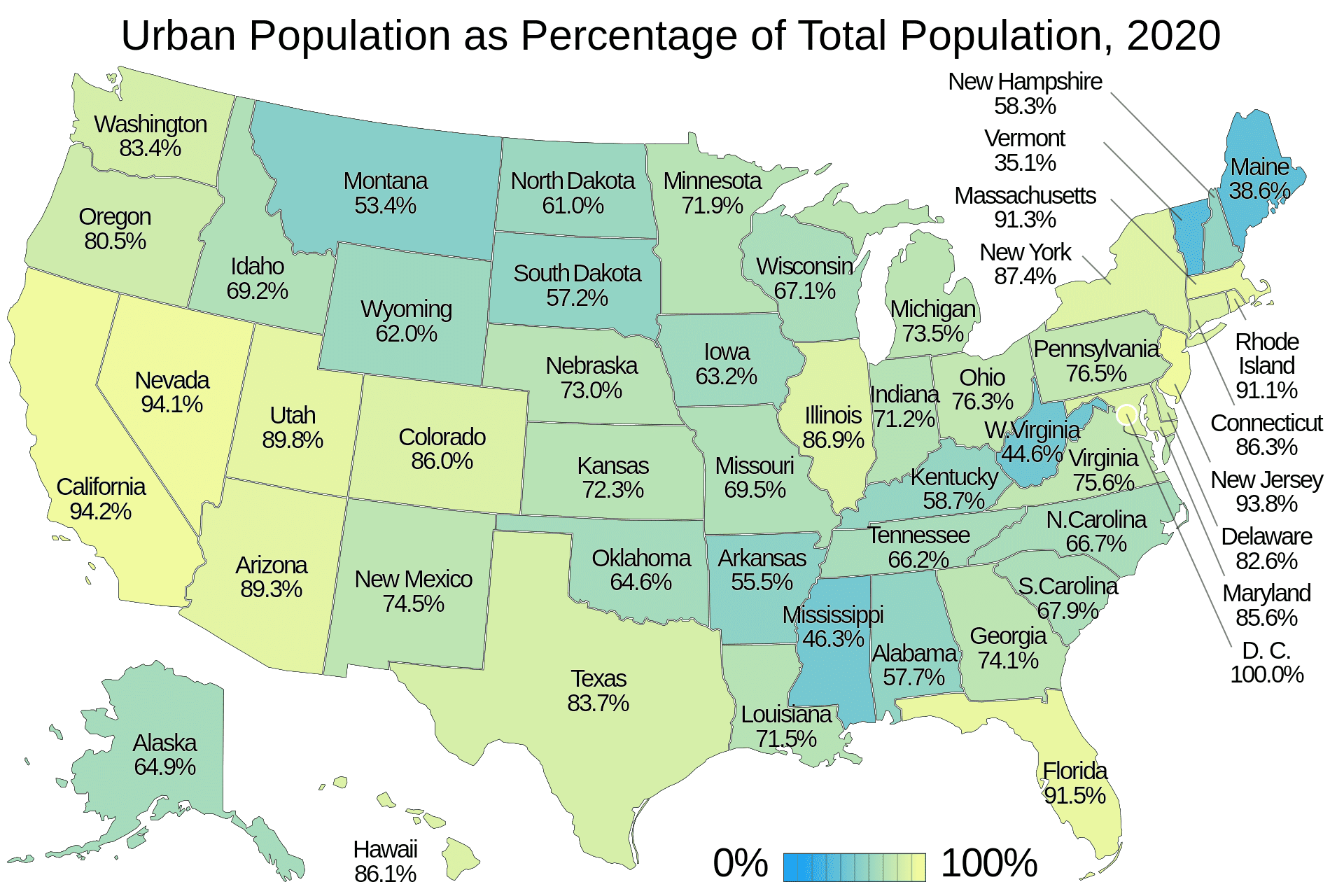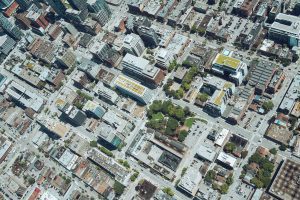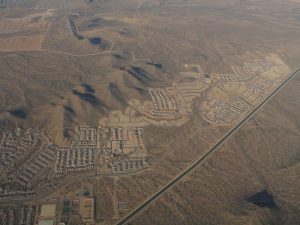Understanding the split in United States’ urban and rural populations begins with knowing the composition and varying lived experiences of individuals in these areas. There might be different perceptions held about what constitutes rural and urban areas, but luckily the U.S. census gives a clear definition for what makes up these communities.

How Does the Census Define Urban Area and Rural Area?
There are many categories the census uses to determine if an area is classified as urban or rural. Things taken into consideration include the number of housing units, distance from an airport, the presence of group quarters, and more. Specifically pertaining to population, in order to be categorized as urban, the territory must have at least 2,000 housing units or a population of at least 5,000. Any area with less than that is classified as rural.
The History of American Urbanization
For much of the history of the U.S., we have been a largely rural country. It wasn’t until between 1910 and 1920 that the population distribution shifted to the majority of U.S. residents living in urban areas over rural.
Why Did People Move to Cities?
People move to cities to further their education, experience the culture, and for economic opportunities. Urban populations continue to climb, and today about 80% of Americans live in a community deemed urban.
Urban Vs Rural Differences
Urban Vs Rural: Race and Ethnicity
According to the 2020 census, people of color now make up over 50% of the population of major urban areas. Of course this varies from city to city with some falling just under and some over the average. Meanwhile, though rural areas also saw an increase in the number of people of color, white residents still make up 76% of the rural U.S. population.
Urban Vs Rural: Poverty
The difference between the amount of people living in poverty in urban areas versus rural is not as large as one might suspect – it’s about a 3% difference nationally. This difference becomes a little more complex when looking across regions of the United States.
Southern regions have an almost 6% gap between urban and rural poverty levels, 3% higher than the national average. Poverty levels in northeastern urban and rural communities were nearly the same, with a gap of only 0.9%. Although important to note, these statistics don’t consider cost of living. Examples such as lack of access to affordable housing in cities and lack of access to public transportation in rural areas impact when and how much money is spent on daily necessities. Those are things that influence the quality of life regardless of if people fall above or below the poverty line.
Urban Vs Rural: Job Opportunities
 Major economic events impact communities in different ways. When either an urban or rural community is struggling to create or maintain jobs, people will leave in search for employment elsewhere. Most recently, the COVID-19 pandemic caused all communities to suffer due to job restrictions. Divergence in experience between the communities came as urban areas saw a higher loss of jobs than rural areas because urban employees were more likely to have ‘nonessential’ jobs. However after the pandemic, urban areas have been able to gain back lost jobs faster than rural areas.
Major economic events impact communities in different ways. When either an urban or rural community is struggling to create or maintain jobs, people will leave in search for employment elsewhere. Most recently, the COVID-19 pandemic caused all communities to suffer due to job restrictions. Divergence in experience between the communities came as urban areas saw a higher loss of jobs than rural areas because urban employees were more likely to have ‘nonessential’ jobs. However after the pandemic, urban areas have been able to gain back lost jobs faster than rural areas.
Even within urban and rural communities, Black, white, and Hispanic or Latinx individuals of prime working age (25-54 years old) have different experiences with unemployment. During the COVID-19 pandemic, in urban communities, Hispanic or Latinx residents saw the highest increase in unemployment, followed by Black residents, then white residents. In rural communities, Black residents had the highest increase in unemployment, followed by white residents, then Hispanic or Latinx residents.
In general, job growth in rural communities is less than a fourth of the national average. The number of residents of prime working age in rural areas continues to drop as more jobs become available in urban areas.
Feelings Toward Communities That Are Not Our Own
With these differences and the physical separation of rural and urban communities, Americans have seen an uptick in “othering” of people in the community that is not theirs. Members of both communities feel misunderstood and looked down on by residents of the opposite community. Both do not believe that people in other places understand the types of problems they and their peers face and believe the opposite community has a negative view of residents in their own.
Specifically in rural areas, people hold resentment toward urban areas as they believe urbanites receive more than their fair share of government resources. News outlets help to reinforce this attitude, focusing coverage primarily on big cities and those who live there.
Where Do Suburbs Fit In?
While the official census data collection does not differentiate between the suburban and urban counties, some research projects choose to do so. Because there is no national standard set for defining a suburban community, this can look different across organizations.
What Is The Definition Of Suburban?
 For example, The Pew Research Center defines suburban counties as areas that surround an “urban core,” which is an area of over 1 million people. Alternatively, some research asks participants to self identify as either urban, suburban, or rural. The National Center for Health Statistics (NCHS) does not identify a suburban group, but breaks down urban communities into widely accepted categories of large (1 million or more people), medium (250,000 to 999,999 people), or small (any urban area under 250,000 people).
For example, The Pew Research Center defines suburban counties as areas that surround an “urban core,” which is an area of over 1 million people. Alternatively, some research asks participants to self identify as either urban, suburban, or rural. The National Center for Health Statistics (NCHS) does not identify a suburban group, but breaks down urban communities into widely accepted categories of large (1 million or more people), medium (250,000 to 999,999 people), or small (any urban area under 250,000 people).
Research identifying suburbs as their own community found that they have a higher percent increase of residents living in poverty between 2000 and 2016 than both urban and rural areas. There was a 51% increase in suburban poverty compared to a 31% increase in urban areas and a 23% increase in rural areas. In contrast to urban and rural residents, most suburban residents say people that do not live in their community view them positively. Additionally, people in suburbs are less likely to think that people in communities other than theirs don’t understand the problems they face.
Why is Learning About Urban, Rural, and Suburban Areas so Important?
Understanding communities other than our own builds empathy for fellow U.S. residents. People struggle with all sorts of things we may not be familiar with, some of which are dependent on something as simple as the amount of people that live in your area.
Image credits: Map (By User:Cmglee. File:Blank US Map (states only).svg is from en:user:Theshibboleth and others who worked on it. – Mapquiz USA states SMIL.svg, CC BY-SA 4.0, Wikimedia Commons); Aerial view of city (Photo by Maarten van den Heuvel on Pexels); Aerial view of suburbs (“Beginning of Phoenix Suburbs, Phoenix, Arizona” by Ken Lund is licensed under CC BY-SA 2.0)


